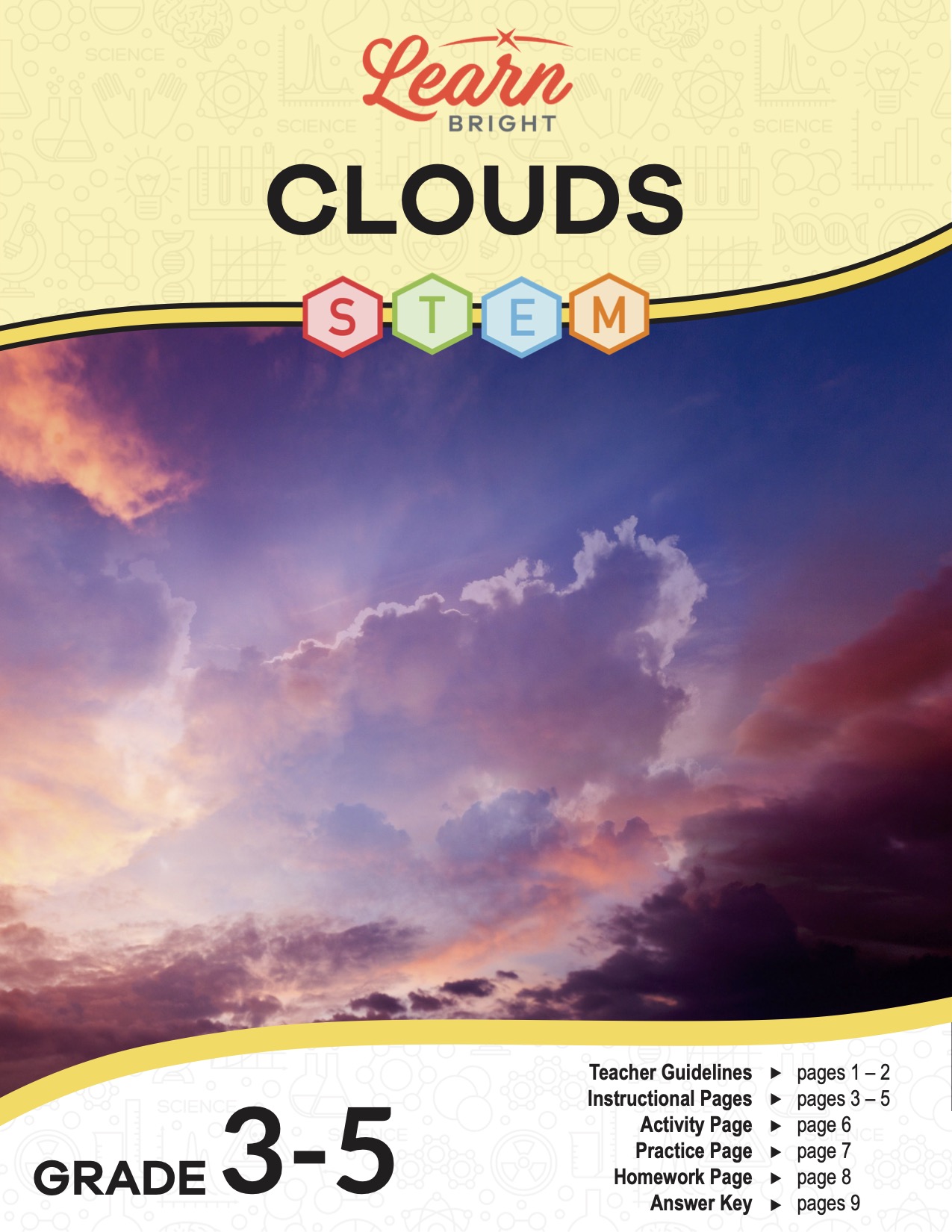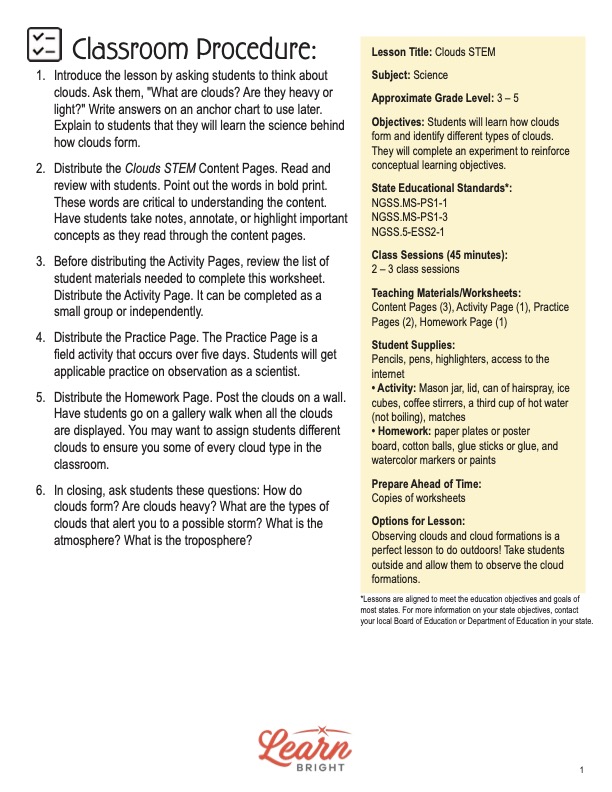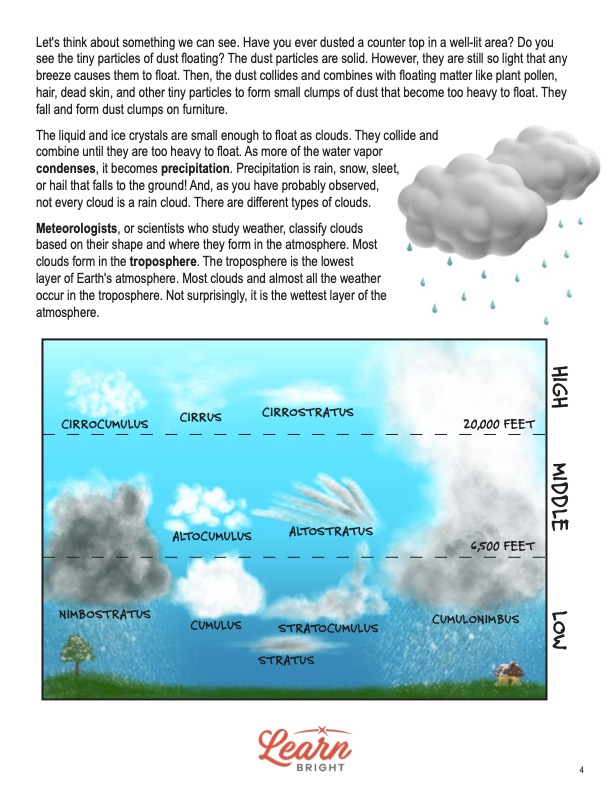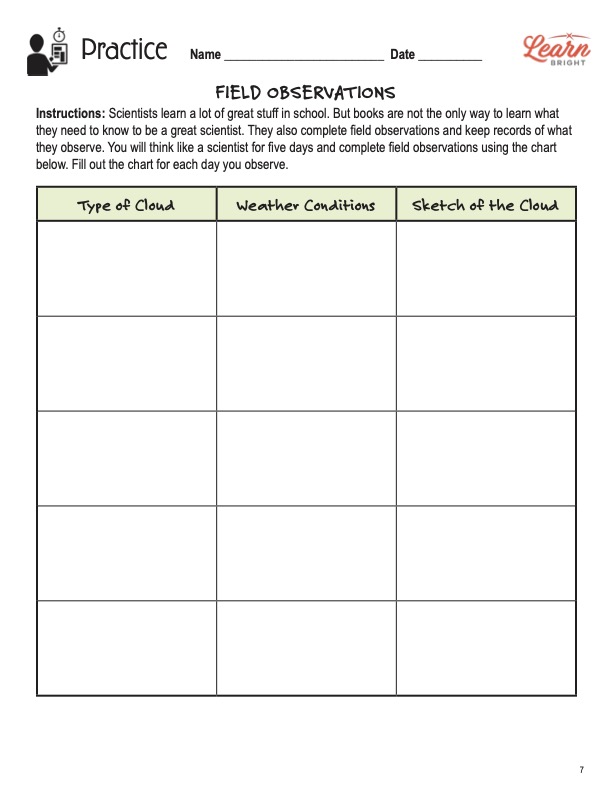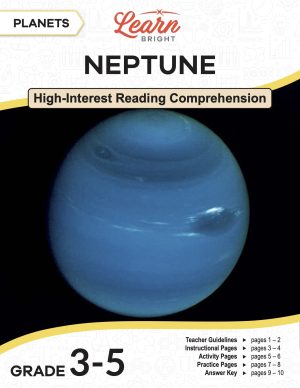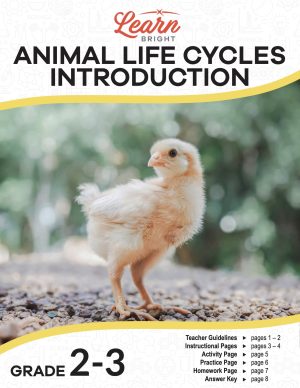Description
What our Clouds STEM lesson plan includes
Lesson Objectives and Overview: Clouds STEM teaches students all about clouds, how they form and why, and what the different types of clouds can tell us about the weather. They will be able to complete an experiment that demonstrates the concepts they learned in the lesson. This lesson is for students in 3rd grade, 4th grade, and 5th grade.
Classroom Procedure
Every lesson plan provides you with a classroom procedure page that outlines a step-by-step guide to follow. You do not have to follow the guide exactly. The guide helps you organize the lesson and details when to hand out worksheets. It also lists information in the yellow box that you might find useful. You will find the lesson objectives, state standards, and number of class sessions the lesson should take to complete in this area. In addition, it describes the supplies you will need as well as what and how you need to prepare beforehand. The activity page lists the materials you’ll need for the two activity options. You can choose to do one or both experiments.
Options for Lesson
In the “Options for Lesson” section of the classroom procedure page, you will see some suggestions for additional activities or ideas to add to the lesson if you want to. Observing clouds and cloud formations is a perfect lesson to do outdoors! Take students outside and allow them to observe the cloud formations. Feel free to experiment with other ideas to add to this lesson plan.
Teacher Notes
The teacher notes page provides an extra paragraph of information to help guide the lesson. It mentions that students will learn that clouds are made of water vapor and ice crystals. You can use the blank lines to write down any other ideas or thoughts you have about the topic as you prepare.
CLOUDS STEM LESSON PLAN CONTENT PAGES
The Atmosphere
The Clouds STEM includes three content pages. When you look into the sky, what do you see? Why, clouds, of course! Because you see clouds nearly every day, you likely haven’t given them much thought. There is a lot of neat science behind how clouds form and why they are essential parts of our environment. What are clouds? How do they form? How are they different from each other? These are all great questions!
The atmosphere comprises the gases that surround the planet. It is where the weather happens. We breathe oxygen from the atmosphere. And the atmosphere is full of water. The water in the atmosphere is made of tiny drops of water that are too small to see. Clouds are water drops or ice crystals that float in the sky. How can a drop of water or an ice crystal float? We will answer that question later.
How Clouds Form
You are probably already familiar with the three major states of matter—solid, liquid, and gas. Our atmosphere is full of water droplets. The droplets are in a gas form called water vapor. Clouds start forming when the liquid water droplets transform into water vapor. One of the more fascinating processes on the earth is the water cycle. As you know, heat rises. Think of steam when you boil water in a pot. Warm air holds more water vapor than cooler air. Large bodies of water, like the oceans, turn water into water vapor when the sun’s rays heat it up.
When water vapor rises, the higher it goes, the cooler and thinner the air is. The cooler air causes the molecules to stick. They stick to dust, ice, or salt from the sea. Clouds form when the warm air and the water vapor cool. So, when you see clouds, you see the ice crystals that form when cool air comes into contact with warm air. That brings up an interesting question. If clouds are made of water, why isn’t it always raining? How can a drop of water or an ice crystal float? More great questions!
Let’s think about something we can see. Have you ever dusted a counter top in a well-lit area? Do you see the tiny particles of dust floating? The dust particles are solid. However, they are still so light that any breeze causes them to float. Then, the dust collides and combines with floating matter like plant pollen, hair, dead skin, and other tiny particles to form small clumps of dust that become too heavy to float. They fall and form dust clumps on furniture.
The liquid and ice crystals are small enough to float as clouds. They collide and combine until they are too heavy to float. As more of the water vapor condenses, it becomes precipitation. Precipitation is rain, snow, sleet, or hail that falls to the ground! And, as you have probably observed, not every cloud is a rain cloud. There are different types of clouds.
Classification of Clouds
Meteorologists, or scientists who study weather, classify clouds based on their shape and where they form in the atmosphere. Most clouds form in the troposphere. The troposphere is the lowest layer of Earth’s atmosphere. Most clouds and almost all the weather occur in the troposphere. Not surprisingly, it is the wettest layer of the atmosphere.
The last page details what each of the cloud types indicate. For instance, cirrus clouds are high, thin and wispy clouds that appear during good weather. On the other end of the spectrum, cumulonimbus clouds are tall and span from low to high level and cause thunderstorms and other strong weather events. At the end of the page is a list of fun facts about clouds.
CLOUDS STEM LESSON PLAN WORKSHEETS
The Clouds STEM lesson plan includes three worksheets: an activity worksheet, a practice worksheet, and a homework assignment. Each one will reinforce students’ comprehension of lesson material in different ways and help them demonstrate when they learned. Use the guidelines on the classroom procedure page to determine when to distribute each worksheet to the class.
MAKE A CLOUD ACTIVITY WORKSHEET
There are two options for the activity worksheet. Students will try to create a cloud of their own using the supplies in the lists. In one experiment, a cloud will escape a jar. In the other, the cloud will form within the jar. Students must follow the steps correctly to ensure the clouds form properly. You are welcome to do one or both activities. Most of the supplies are the same for the two experiments.
FIELD OBSERVATIONS PRACTICE WORKSHEET
For the practice worksheet, students will practice being scientists as they observe the sky for a few days. They will complete the field observations chart by describing the clouds they see for five days. They will also record the weather conditions on each day and sketch the clouds in the boxes in the right column. The objective of the assignment is for students to demonstrate their understanding of the information they learned.
CLOUDS STEM POSTER HOMEWORK ASSIGNMENT
The homework assignment requires students to present their favorite cloud. Students will use the supplies from the list to complete the assignment. They will first color a paper plate or poster board to look like the sky. Using cotton balls, they will make their favorite cloud. Once they finish, they will need to label the cloud they created. Display the finished posters in the classroom. You can assign students cloud types as well to make sure there is a good variety.
Worksheet Answer Keys
Given the nature of these assignments, there are no answer keys with specific right answers. The practice worksheet has an answer key that simply explains what students need to aim for during the assignment. Ensure your students’ work make sense according to the clouds they observed and wrote about/drew.

